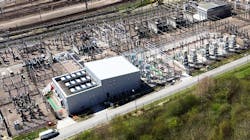Undersea Railway Channel Tunnel to Get STATCOM System
The Channel Tunnel, the longest undersea tunnel in the world, reached a technological milestone with Getlink’s commissioning of a high-voltage grid solution from GE Renewable Energy’s Grid Solutions business. GE’s flexible Static Synchronous Compensator (STATCOM) solution delivers the fast voltage support Eurotunnel requires to be able to run up to 16 trains simultaneously in the Channel Tunnel—a 60% increase in maximum capacity or as many as 1,000 trains per day.
The busiest and most heavily used rolling motorway in the world, Eurotunnel decided to increase the power and stability of its network to ensure a constant flow of traffic and meet peak demand when multiple trains run simultaneously. The STATCOM solution, developed by GE and adapted to the Channel Tunnel in collaboration with Eurostar, supports voltage stability, grid resilience, and enhanced power transfer capability.
The solution stabilizes the voltage of the power network—a major problem for power systems—with its ability to either absorb or generate reactive power in synchronization with demand. The STATCOM solution will double the reactive compensation power flow as well as improve stability even during peak periods and deliver enhanced quality of service, by enabling optimized regularity of the freight and passenger shuttle service.
GE’s STATCOM technology should enable the Channel Tunnel infrastructure to remain in place for the long term. Expected traffic growth will facilitate the access to a new generation of speed trains, which will support the development of new cross-Channel services.
"By improving the efficiency of the infrastructure and increasing the number of trains running through the tunnel, this new technological advance will support our ambitious target of carrying 30 million passengers a year by 2030, across our network," said Amar Chaabi, chief operations officer of Eurostar Group.
GE custom-designed and supplied the entire STATCOM system, including its adaptive SmoothSine control system, which provides the Eurotunnel with reactive power compensation and an improved range of operational voltage, leading to faster response times. Additionally, this technology has a smaller physical footprint than traditional Static Var Compensation (SVC)2 systems.
